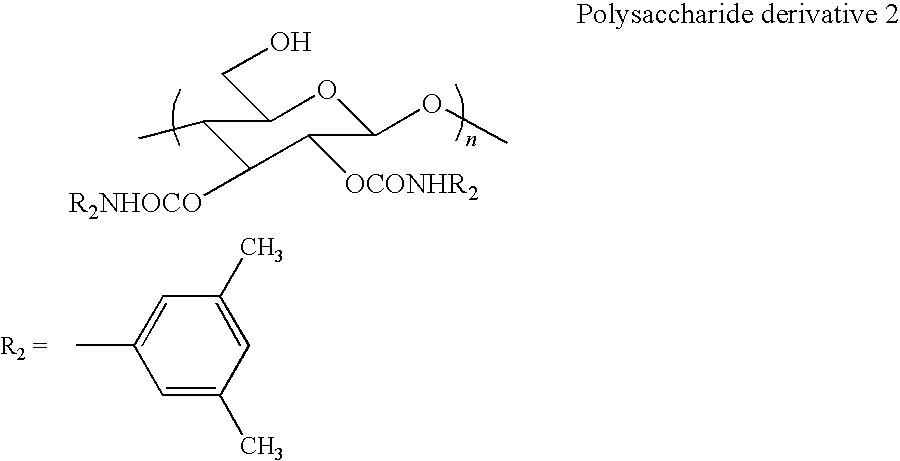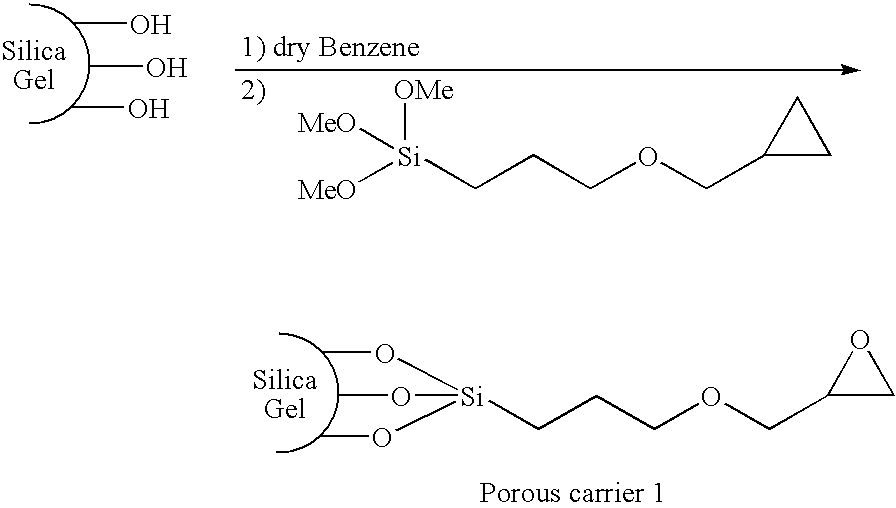Separating agent for enantiomeric isomers
a technology of enantiomeric isomers and separation agents, which is applied in the direction of separation processes, other chemical processes, instruments, etc., can solve the problems of limited solvents for dissolving polysaccharide derivatives, and limited solvents for dissolving samples, etc., and achieves sufficient solvent resistance and high optical resolving power inherent
- Summary
- Abstract
- Description
- Claims
- Application Information
AI Technical Summary
Benefits of technology
Problems solved by technology
Method used
Image
Examples
synthesis example 1
[0039]Synthesis of polysaccharide derivative 1 (6-O-tritylcellulose) represented by the following formula
[0040]
[0041]Into a 500-ml three-necked flask, cellulose (5.03 g, 31 mmol), LiCl (3.40 g, 81 mmol), and N,N-dimethylacetamide (50 ml) were added, and the mixture was swollen at 80° C. for several hours. Then, trityl chloride (38.3 g, 137 mmol) and pyridine (100 ml) were added to the mixture and a reaction was carried out for 12 hours. A product was reprecipitated in methanol and collected through centrifugation.
synthesis example 2
[0042]Synthesis of polysaccharide derivative 2 [2,3-bis(3,5-dimethylphenyl carbamate)cellulose] represented by the following formula
[0043]
[0044]The polysaccharide derivative 1 (1.08 g, 2.67 mmol) and pyridine (15 ml) were added, and then 3,5-dimethylphenyl isocyanate (1.59 g, 10.7 mmol) was added. A reaction was carried out at 80° C. for 18 hours to thereby convert hydroxyl groups at 2- and 3-positions to carbamates. The obtained precipitate was reprecipitated in methanol and was washed with methanol through centrifugation until pyridine was completely removed. Then, a protecting group of a hydroxyl group at a 6-position was removed by using an acid (HCl / methanol=1 / 50). A product was sufficiently washed with methanol and collected through centrifugation.
synthesis example 3
[0045]Synthesis of porous carrier 1 (silica gel having an epoxy group introduced thereinto) represented by the following formula
[0046]
[0047]Benzene (80 ml), (3-glycidoxypropyl)trimethoxysilane (4 ml), and pyridine (0.2 ml) were added to 8.1 g of silica gel (particle size of 7 μm, pore size of 1,000 Å). A reaction was carried out at 80° C. for 17 hours. A product was sufficiently washed with methanol, acetone, and hexane in the order given, and was collected through a 4G-glass filter. An introduction ratio of the epoxy group was determined by measuring a content of an organic substance through thermogravimetric analysis.
PUM
| Property | Measurement | Unit |
|---|---|---|
| particle size | aaaaa | aaaaa |
| particle size | aaaaa | aaaaa |
| particle size | aaaaa | aaaaa |
Abstract
Description
Claims
Application Information
 Login to View More
Login to View More - R&D
- Intellectual Property
- Life Sciences
- Materials
- Tech Scout
- Unparalleled Data Quality
- Higher Quality Content
- 60% Fewer Hallucinations
Browse by: Latest US Patents, China's latest patents, Technical Efficacy Thesaurus, Application Domain, Technology Topic, Popular Technical Reports.
© 2025 PatSnap. All rights reserved.Legal|Privacy policy|Modern Slavery Act Transparency Statement|Sitemap|About US| Contact US: help@patsnap.com



